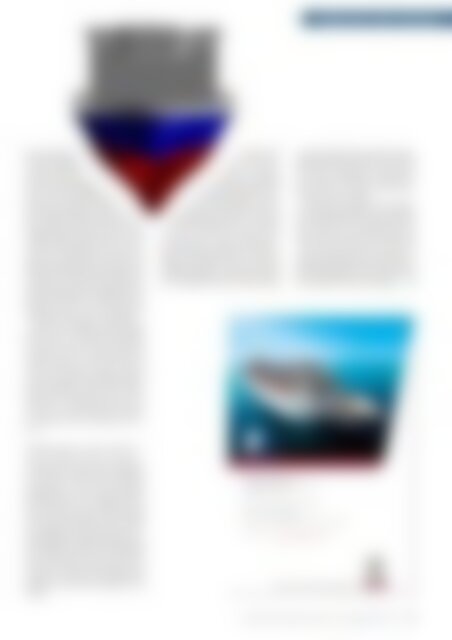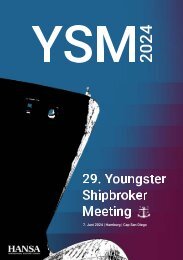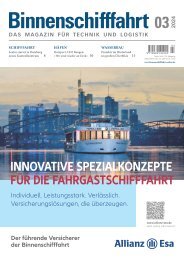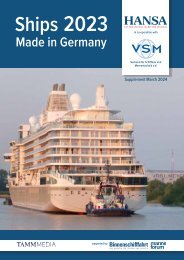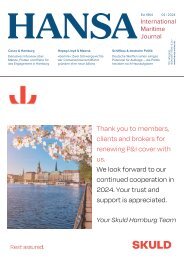HANSA 03-2018
Propeller Performance | Koalitionsvertrag | Jubiläum ZVDS | Robotik im Hafen | Ballastwasser Survey 2018 | Finanz- und Schifffahrtsstandort Nordamerika | Zeaborn & Rickmers
Propeller Performance | Koalitionsvertrag | Jubiläum ZVDS | Robotik im Hafen | Ballastwasser Survey 2018 | Finanz- und Schifffahrtsstandort Nordamerika | Zeaborn & Rickmers
Erfolgreiche ePaper selbst erstellen
Machen Sie aus Ihren PDF Publikationen ein blätterbares Flipbook mit unserer einzigartigen Google optimierten e-Paper Software.
Schiffstechnik | Ship Technology<br />
parts of the ship.<br />
»We feel as though<br />
we have solved the<br />
problem of vapour return,<br />
which is the biggest<br />
issue in the LNG bunkering<br />
business,« the Project Director<br />
says. When loading an LNG carrier,<br />
the vapour can be returned to shore.<br />
When bunkering a ship, you have to deal<br />
with that vapour on board. »You can use a<br />
number of technologies, CNG is our primary<br />
one. We compress the vapour on our<br />
ship, but you have to have a voyage to use<br />
the CNG. If the ship remains in a port for<br />
a long time or does not exit its home port,<br />
then you haven’t got the capability to burn<br />
the LNG. Therefore, we will install a reliquefaction<br />
unit or sub-cooler that takes<br />
care of the vapour return,« he explains.<br />
The key to a bunker vessel is the gas<br />
process, he says. »Without it being right,<br />
all you have is an LNG feeder vessel. But<br />
a bunker vessel is very specialized, the<br />
transfer system, the vapour return and<br />
the boil-off control are critical. Thus, at<br />
a very early stage we teamed up with a<br />
process company – Babcock LGE, BSM’s<br />
50% joint venture partner and co-owner<br />
of the vessel – and they have become true<br />
partners. So, the providers never leave<br />
us, which de-risks our ships for the future.«<br />
The ship will<br />
be time chartered<br />
to Nauticor<br />
and will be operated<br />
in the Baltic based at the<br />
independent FSRU in Lithuania.<br />
Commenting on future<br />
prospects for the GSV sector in<br />
BSM, Eltringham states: »Certainly<br />
we do not want to have only one GSV,<br />
we want to have many.« All the traditional<br />
bunker are considered viable: Singapore,<br />
Rotterdam/Europe or the Mississippi<br />
area with its cruise vessels. »The<br />
world is changing, a year ago I wouldn’t<br />
have thought that there would be large<br />
container ships with membrane atmospheric<br />
tanks for fuel. But now with CMA<br />
CGM there are going to be such vessels.<br />
So you have to adapt your technology to<br />
that, which we can with a process company<br />
on board,« he adds.<br />
Another key for BSM is crew training.<br />
Since trained personnel in this new business<br />
iwill be a really critical point, the new<br />
GSV will also be a training school. The<br />
Project Director explains »on a large scale<br />
LNG carrier, the crew does not see any<br />
cargo operations during a trip. But on a<br />
bunkering vessel there can be LNG transfers<br />
every day and you can acquire a lot of<br />
knowledge and experience quickly.« M<br />
World changes in favour of LNG<br />
The LNG will be stored in two independent<br />
IMO type C tanks which are designed<br />
to contain the LNG with a minimum<br />
temperature of -165 °C and maximum<br />
vapour pressure of 3.75 bar(g), and can<br />
be transferred to an LNG-fuelled vessel at<br />
the rate of about 1,250 m³/hour through<br />
the cryogenic flexible hoses. The natural<br />
vaporising gas from the bunkering vessel<br />
and the returned boil-off gas from the<br />
LNG-fuelled vessel will be compressed<br />
up to 220 bar(g), stored in two sets of 40’<br />
containers and used for propulsion fuel<br />
and electric. The tanks are produced by<br />
Jiangnan in China but are Babcock LGE<br />
design.<br />
BUREAU VERITAS SA<br />
Zweigniederlassung Hamburg<br />
Marine Department<br />
Veritaskai 1, 21079 Hamburg<br />
Tel.: +49 40 23625-0<br />
Fax: +49 40 2 36 25-620<br />
E-Mail: ger_cha@de.bureauveritas.com<br />
Visit us on: www.bureauveritas.de<br />
www.veristar.com<br />
<strong>HANSA</strong> International Maritime Journal – 155. Jahrgang – <strong>2018</strong> – Nr. 3 65


